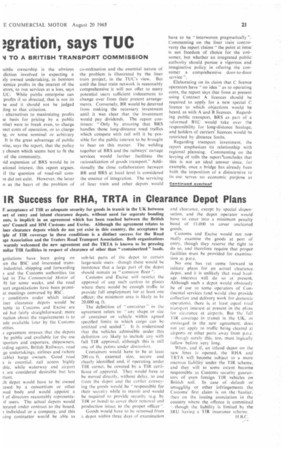IR Success for RHA, TRTA in Clearance Depot Plans
Page 25

If you've noticed an error in this article please click here to report it so we can fix it.
F. acceptance of TIR as adequate security for goods in transit in the UK between ort of entry and inland clearance depots, without need for separate bonding ents, is implicit in an agreement which has been reached between the British lers' Council and HM Customs and Excise. Although the agreement relates to iner clearance depots which do not yet exist in this country, the acceptance in iple of TIR coverage in these conditions is a distinct success for the Road tge Association and the Traders Road Transport Association. Both organizations warmly welcomed the new agreement and the TRTA is known to be pressing lunar TIR facilities in respect of clearance of other than " containerized " loads.
gotiations have been going on :cn the BSC and interested transindustrial, shipping and forwarding s and the Customs authorities (as led in The Commercial Motor of 9) for some weeks, and the road 3ort organizations have been .prorniat meetings convened by BSC.
2 conditions under which inland hoer clearance depots would be table to Customs and Excise are ed but fairly straightforward; more nation about the requirements is to ade available later by the Customs trities.
agreement stresses that the depots be public and available for the use vorters and exporters, shipowners, nding agents, British Railways, road ge undertakings, airlines and (where 2ahle) barge owners. Good .road s is essential, rail access highly ible, while waterway and airport s are considered desirable but less rtant.
:h depot would have to be owned :ased by a consortium or other wed body and would appoint a I of directors reasonably representa)1 users. The actual depots would terated under contract to the board, individual or a company, and this Liing contractor would be able to sub-let parts of the depot to certain large-scale users .-though there would he insistence that a large part of the depot should remain as " common floor ".
Customs and Excise will restrict the approval of any such centres to places where there would be enough traffic to provide fill employment for at least one officer; the minimum area is likely to be 20.000 sq. ft.
The definition of "container " in the agreement refers to: '' any shape or size of container or vehicle within agreed specified limits in which cargo can be unitized and sealed ". It is understood that the vehicles admissible under this definition are likely to include any with full TIR approval, although this is still one of the points under discussion.
Containers would have to be at least 200 Cu. ft. external size. secure and clearly identified and, if operating under TIR carnet, be covered by a TIR certificate of approval. They would have to be moved directly, without delay, to and from the depot and the carrier conveying the goods would be "responsible for their security while in transit and would be required to provide security te.g. by 'Ilk or bond) to cover their removal and production intact to the proper officer ".
Goods would have to be removed from a depot within three days of examination and clearance. except by special dispensation, and the depot operator would have to enter into a minimum penalty bond of f 1.000 to cover uncleared goods.
Customs and Excise would not normally examine the goods at port of entry, though they reserve the right to doso, and therefore require that proper facilities must be provided for examination at p.o.e.
No one has yet come forward to initiate plans for an actual clearance depot. and it is unlikely that road haulage interests will do so at present. Although such a depot would obviously he of use to some operators of Continental services (and would also provide collection and delivery work for domestic.. operators). there is at least equal road transport interest at present in the plans for clearance at airports. But 'the full TlR coverage in transit in the UK, as envisaged in the new agreement, does not yet apply to traffic being cleared at airports or other ports away from p.o.e. -though surely -this, too, must logically follow before very long.
When, and if, an inland depot on the new lines is, opened, the RHA and TRTA will become subject to a more onerous liability under the TIR scheme.. and they will to some extent become responsible as Customs security guarantors of even foreign TIR vehicles on
British soil. In ease of _default or smuggling or other -infringements the Customs' first claim is on the "haulier. then on the issuing association in the country where the offence is committed L--though the liability. is limited by the EAU having a TIR insurance scheme,




















































































































